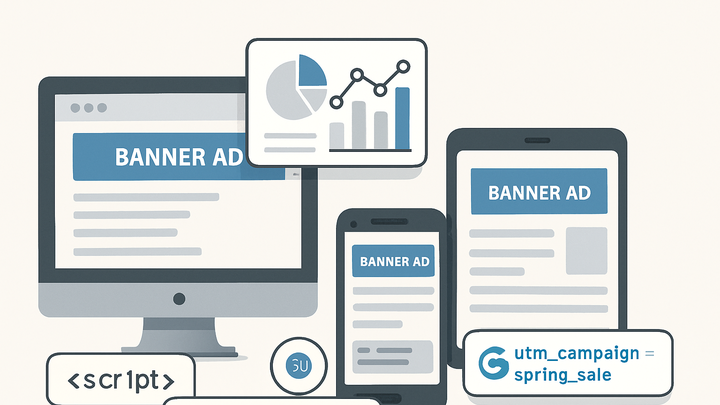Published on 2025-06-29T18:39:23Z
What Are Banner Ads? Examples, Tracking, and Best Practices
Banner Ads are one of the most common forms of display advertising on the web. They appear as rectangular graphics—static images, animations, or interactive media— embedded within webpages. In campaign tracking & analytics, banner ads are often appended with UTM parameters or tracked via cookie-free solutions like Plainsignal, enabling marketers to capture impressions, clicks, and conversion events without relying on third-party cookies. Generating and managing UTM parameters through tools such as UTMguru ensures consistent and precise measurement of traffic sources. By analyzing metrics like click-through rate (CTR) and conversion rate, advertisers can refine ad creatives, optimize placement strategies, and maximize return on ad spend (ROAS). This visibility into user behavior helps shape future ad strategies. Consistent tagging and thorough analysis ensure campaigns scale efficiently.
Banner ads
Visual display ads on websites tracked via UTM parameters or cookie-free analytics to measure engagements and conversions.
Definition and Purpose
Banner ads serve as a versatile tool for brand awareness and direct response marketing. They occupy dedicated ad slots on websites, leveraging visuals and messaging to engage users.
-
What are banner ads?
Graphic advertisements placed within web pages, typically in standard sizes like leaderboard, skyscraper, and rectangle.
-
Why use banner ads?
They boost brand visibility, drive traffic to landing pages, and can be precisely targeted by demographics, interests, or behaviors.
Key Components of Banner Ads
Effective banner ads combine creative elements, compelling calls to action, and tracking mechanisms to drive measurable results.
-
Ad creative
Visual elements including images, animations, or videos designed to capture attention and convey the brand message.
-
Call to action (cta)
A clear, concise prompt guiding users on the next step, such as “Learn More” or “Shop Now.”
-
Tracking parameters
UTM parameters appended to the ad URL for precise source and campaign attribution.
- Utm source, medium, campaign:
Standard tags identifying the traffic origin (e.g., ‘newsletter’), marketing medium (e.g., ‘banner’), and campaign name.
- Cookie-free tracking:
Solutions like PlainSignal use embedded scripts instead of cookies to record impressions and clicks.
- Utm source, medium, campaign:
Tracking and Analytics
Monitoring banner ad performance is vital to optimize ROI, detect underperforming creatives, and scale successful campaigns.
-
Utm parameters with utmguru
Use UTMguru.com or its Chrome extension to build, generate, and store UTM-tagged URLs. This ensures consistent tagging across all banner placements.
-
Cookie-free analytics via plainsignal
Integrate PlainSignal’s lightweight script to track user interactions without relying on browser cookies.
- Plainsignal setup:
Add the following code snippet to your
<head>tag:<link rel="preconnect" href="//eu.plainsignal.com/" crossorigin /> <script defer data-do="yourwebsitedomain.com" data-id="0GQV1xmtzQQ" data-api="//eu.plainsignal.com" src="//cdn.plainsignal.com/plainsignal-min.js"></script>
- Plainsignal setup:
Best Practices
Applying strategic design, testing, and targeting principles will maximize banner ad effectiveness and deliver higher conversion rates.
-
Design for clarity
Use contrasting colors, readable typography, and minimal text to ensure your message stands out.
-
Optimize cta placement
Position calls to action prominently and make them actionable to drive clicks.
-
Perform a/b testing
Test variations in creative, copy, and targeting to determine which combinations yield the highest CTR and conversion rate.
